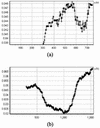Rational design of DNA sequence-based strategies for subtyping Listeria monocytogenes
- PMID: 12202573
- PMCID: PMC130781
- DOI: 10.1128/JCM.40.9.3319-3325.2002
Rational design of DNA sequence-based strategies for subtyping Listeria monocytogenes
Abstract
The ability to differentiate bacteria beyond the species level is essential for identifying and tracking infectious disease outbreaks and to improve our knowledge of the population genetics, epidemiology, and ecology of bacterial pathogens. Commonly used subtyping methods, such as serotyping, phage typing, ribotyping, and pulsed-field gel electrophoresis, can yield ambiguous results that are difficult to standardize and share among laboratories. DNA sequence-based subtyping strategies can reduce interpretation ambiguity. We report the development of a rational approach for designing sequence-based subtyping methods. Listeria monocytogenes was selected as the model organism for testing the efficacy of this approach. Two housekeeping genes (recA and prs), one stress response gene (sigB), two virulence genes (actA and inlA), and two intergenic regions (hly-mpl and plcA-hly) were sequenced for 15 L. monocytogenes isolates. Isolates were chosen from a representative collection of more than 1,000 L. monocytogenes isolates to reflect the genetic diversity of this species. DNA sequences were aligned, and sliding window analyses were performed for each gene to define 600-bp-long regions that were (i) most polymorphic (using ProSeq) or (ii) most discriminatory (using a new algorithm implemented in WINDOWMIN). Complete gene sequences for actA (1,929 bp) and inlA (2,235 bp) provided the highest discrimination (identifying 15 and 14 allelic types, respectively). WINDOWMIN allowed identification of 600-bp regions within these genes that provided similar discriminatory power (yielding 15 and 13 allelic types, respectively). The most discriminatory 600-bp fragments identified in the housekeeping and stress response genes differentiated the isolates into 8 to 10 subtypes; intergenic region sequences yielded 8 and 12 allelic types based on 335- and 242-bp sequences for hly-mpl and plcA-hly, respectively. Regions identified as most polymorphic were not necessarily most discriminatory; therefore, application of the WINDOWMIN algorithm provided a powerful tool for determining the best target regions for DNA sequence-based subtyping. Our specific results also show that inclusion of virulence gene target sequences in a DNA sequence-based subtyping scheme for L. monocytogenes is necessary to achieve maximum subtype differentiation.
Figures

References
-
- Chan, M. S., M. C. J. Maiden, and B. G. Spratt. 2001. Database-driven multi locus sequence typing (MLST) of bacterial pathogens. Bioinformatics 17:1077-1083. - PubMed
-
- Enright, M., K. Knox, D. Griffiths, D. Crook, and B. Spratt. 2000. Molecular typing of bacteria directly from cerebrospinal fluid. Eur. J. Clin. Microbiol. Infect. Dis. 19:627-630. - PubMed
Publication types
MeSH terms
Substances
Associated data
- Actions
- Actions
- Actions
- Actions
- Actions
- Actions
- Actions
- Actions
- Actions
- Actions
- Actions
- Actions
- Actions
- Actions
- Actions
- Actions
- Actions
- Actions
- Actions
- Actions
- Actions
- Actions
- Actions
- Actions
- Actions
- Actions
- Actions
- Actions
- Actions
- Actions
- Actions
- Actions
- Actions
- Actions
- Actions
- Actions
- Actions
- Actions
- Actions
- Actions
- Actions
- Actions
- Actions
- Actions
- Actions
- Actions
- Actions
- Actions
- Actions
- Actions
- Actions
- Actions
- Actions
- Actions
- Actions
- Actions
- Actions
- Actions
- Actions
- Actions
- Actions
- Actions
- Actions
- Actions
- Actions
- Actions
- Actions
- Actions
- Actions
- Actions
- Actions
- Actions
- Actions
- Actions
- Actions
- Actions
- Actions
- Actions
- Actions
- Actions
- Actions
- Actions
- Actions
- Actions
- Actions
- Actions
- Actions
- Actions
- Actions
- Actions
- Actions
- Actions
- Actions
- Actions
- Actions
- Actions
- Actions
- Actions
- Actions
- Actions
- Actions
- Actions
- Actions
- Actions
- Actions
Grants and funding
LinkOut - more resources
Full Text Sources
Other Literature Sources

